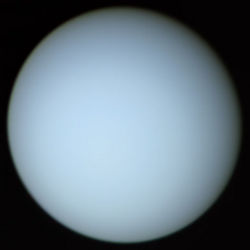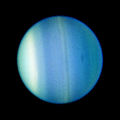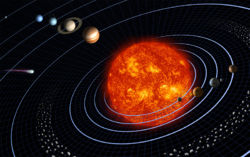Uranus
 From Conservapedia
From Conservapedia | Uranus | |
|---|---|
 This picture of Uranus was compiled from images recorded by Voyager 2 on January 10, 1986, when the NASA spacecraft was 18 million kilometers (11 million miles) from the planet. | |
| Symbol | |
| Date of discovery | March 13, 1781[1] |
| Name of discoverer | William Herschel[1] |
| Name origin | Roman (and Greek) name for heaven and father of Saturn.[1] |
| Orbital characteristics | |
| Primary | Sun |
| Order from primary | 8 |
| Perihelion | 2,741,300,000 km (18.324 AU)[2] |
| Aphelion | 3,003,620,000 km (20.078 AU)[2] |
| Semi-major axis | 2,872,460,000 km (19.201 AU)[2] |
| Titius-Bode prediction | 19.6 AU |
| Circumference | 120.515 AU |
| Orbital eccentricity | 0.0457[2] |
| Sidereal year | 84.0016846 a[3] |
| Synodic year | 369.65 da[2] |
| Avg. orbital speed | 6.8352 km/s[3] |
| Inclination | 0.744° to the ecliptic |
| Rotational characteristics | |
| Sidereal day | -17.24 h[3] |
| Axial tilt | 97.86°[3] |
| Physical characteristics | |
| Density | 1,318 kg/m³[3] |
| Mean radius | 25,362 km[3] |
| Equatorial radius | 25,559 km[3] |
| Polar radius | 24,973 km[3] |
| Surface gravity | 8.69 m/s²[3] |
| Escape speed | 21.30 km/s[3] |
| Surface area | 8,084,000,000 km² |
| Mean temperature | 76 K[3] |
| Number of moons | 27 |
| Composition | 83% hydrogen, 15% helium and 2% methane[4][5] |
| Color | blue-green |
| Albedo | 0.51[3] |
| Magnetosphere | |
| Magnetic flux density | 0.228 G (2.28 * 10-5 T)[2] |
| Magnetic dipole moment at present | 3 * 1024 N-m/T[6] |
| Magnetic dipole moment at creation | 2.05 * 1025 N-m/T[7] |
| Decay time | 3195 a[8] |
| Half life | 2215 a[8] |
Uranus is the seventh planet from the Sun, and the third largest. To superficial appearances, it is featureless and dull. Yet, the circumstances of its formation and the characteristics of the system of moons and rings that encircle it make it one of the most remarkable planets in all the Solar System.
Contents
- 1 Discovery
- 2 Orbital characteristics
- 3 Rotational characteristics
- 4 Physical characteristics
- 4.1 Atmosphere
- 4.2 Magnetosphere
- 5 Ring system
- 6 Difficulties for naturalistic theories
- 6.1 Formation of the planet
- 6.2 Orientation of the Uranian system
- 6.3 The magnetic field
- 6.4 Radiation of energy
- 7 Satellites
- 8 Missions to Uranus
- 9 Gallery
- 10 References
Discovery[edit]
William Herschel discovered Uranus in 1781. He therefore earned a distinction as the first astronomer to discover a planet not previously known to the ancients. He at first wished to name this world "The Georgian Sidus" after King George III of Great Britain. But Johann Bode named Uranus after the convention of naming planets after classical gods and goddesses. In this case, Bode named Uranus after the god of heaven and father of all the other classical gods.
Orbital characteristics[edit]
Uranus's average distance from the Sun (semi-major axis) is 19.1 AU, which is close to the 19.6 AU predicted by the Titius-Bode law. Its sidereal year is 84.02 Earth years. Its orbital eccentricity is 0.046, which means that its orbit is nearly circular (though the orbit of Earth is more circular still). Uranus's orbit is very slightly inclined to the plane of the ecliptic; in fact its orbital inclination with respect to the ecliptic is the least of those of all the planets.
Rotational characteristics[edit]
Uranus's sidereal day is 17.24 Earth hours. Uranus's rotation is retrograde with respect to its orbit around the Sun and the orbits of most of the other planets. Moreover, its axis is tilted 97.86° with respect to its orbital plane, so that in a sense the planet is rolling on its side.
Physical characteristics[edit]
Uranus is a gas giant having a radius of 25,559 km (15,882 miles). Uranus's atmosphere is about 83% hydrogen, 15% helium, and 2% methane. The methane, more than any other constituent, gives Uranus its color.[5]
Atmosphere[edit]
Voyager 2 did not resolve many more features than can be seen through an ordinary earthbound telescope. But seven years of observation by the Hubble Space Telescope have shown that Uranus's atmosphere is quite active. It has even developed a visible storm (the dark spot), which Voyager 2 did not capture.
Magnetosphere[edit]
Uranus has a magnetic field whose axis is oriented 60° away from its rotational axis and, furthermore, is displaced from the center of mass by as much as one-third the planet's radius. Comparison of Uranus' present magnetic dipole moment with the expected magnetic dipole moment at creation[7] suggests a magnetic-field half-life of 2215 Julian years, slightly more than 1.5 times the half-life of the magnetic field of earth.
Ring system[edit]
Uranus has a total of thirteen rings. The brightest of these is the epsilon ring, which was until recently assumed to be the outermost. However, the Hubble telescope team subsequently discovered three more rings lying much further out from Uranus, together with another inner satellite, Mab, closely associated with one of them.
Difficulties for naturalistic theories[edit]
Formation of the planet[edit]
The nebular hypothesis would not even have allowed Uranus and its twin, Neptune, to form at its tremendous distance from the Sun in the time generally allotted. As the journal Astronomy stated the problem:
| “ | Pssst … astronomers who model the formation of the solar system have kept a dirty little secret: Uranus and Neptune don’t exist. Or at least computer simulations have never explained how planets as big as the two gas giants could form so far from the sun. Bodies orbited so slowly in the outer parts of the sun’s protoplanetary disk that the slow process of gravitational accretion would need more time than the age of the solar system to form bodies with 14.5 and 17.1 times the mass of Earth. | ” |
Of course, the time allotted for the formation of the Solar System is generally taken to be the alloted age of the Earth. The problem is that Uranus and Neptune would require more than twice the supposed age of the earth to accrete their present masses. In theory, the Solar System could be older than the Earth itself, but not much older. The Solar System has other bodies in it that are much "younger." Nor does the above account for the body of evidence that the solar system is in fact quite young.
The astrophysicist Steven J. Desch[10] recognizes the problem, and supports a radical alteration of the nebula hypothesis that calls for a decretion disk, not an accretion disk. But even his model requires that Uranus and Neptune exchange places early in the process, primarily because Neptune, though about 10 AU further out from the Sun than is Uranus, is yet more massive.
Orientation of the Uranian system[edit]
According to evolutionary theories of how the solar system formed (i.e., the nebular hypothesis), Uranus's axis should not be tilted 98 degrees with respect to its orbit. Moreover, its moons orbit Uranus around its equator, like the hands of a clock around a clock face. Uranus' thirteen rings also are around its equator, so they look vertical. The nebular hypothesis predicts none of these observations.
Naturalistic astronomers theorize that Uranus originally formed upright, but suffered a collision with another object, producing its severe tilt. This, however, raises more questions:
- Why is its orbit less eccentric than those of all the other planets except only those of Venus, Neptune, and Earth?
- Why is Uranus's orbit less inclined to the ecliptic than is that of any planet except Earth?
- Why are the orbits of Uranus's moons so slightly inclined with respect to Uranus's present equator?[11] Indeed, the vertical orientation of Uranus's moons and of some of its rings was already well known to astronomers before the Voyager 2 flyby. If the moons formed before the collision, then another series of precisely timed collisions would have been required to change the azimuths of all the orbits, and the rings—an absurd violation of Occam's razor. And if they formed after the collision, then in the absence of any condensing gas cloud, they ought to be inclined at random.
Naturalists try to explain that last by suggesting that Uranus's moons are leftover debris from the collision that tilted its axis. However, Uranus's moons make up only one hundredth of one percent of the mass of the planet, and an impact violent enough to knock the giant over would have produced far more debris than that. (Earth's Moon, also supposed to be the result of a giant collision involving its primary, has a mass of 1.23% that of earth.)[11][12] Moreover, not only are the moons of Uranus oriented well to Uranus's equator, but many of them orbit retrograde to Uranus's own rotation.
The magnetic field[edit]
The strength of Uranus' magnetic field presented a problem when Voyager 2 flew by the planet in 1986. According to the classic dynamo theory, Uranus should not have an appreciable magnetic dipole moment. That it has, did not surprise creationists, because Dr. Russell Humphreys predicted its strength from his own model of the creation of celestial magnetic fields. Humphreys published his model two years before Voyager reconnoitered Uranus.[6][7]
As mentioned, Uranus' magnetic axis is 60 degrees displaced from Uranus' axis of rotation. It is also displaced from the planet's center by about one-third of the planet's radius. The dynamo theory cannot account for such vast discrepancies. Humphreys' model says nothing about the alignment of a body's magnetic axis with respect to its rotational axis, so these findings do not compromise this model. Humphreys suggests that the displacement results from the asymmetric accretion of additional matter into Uranus' core after the planet's creation. The dynamo theory would have difficulty with this concept, because a dynamo requires a liquid core.[6]
Radiation of energy[edit]
The other three gas giants (Jupiter, Saturn, and Neptune) radiate more energy than they absorb from the Sun. Uranus does not. Yet Uranus and Neptune are of comparable size, mass, atmospheric composition, and length of the sidereal day. No naturalistic theory can account for this salient difference. Uranus's peculiar lack of an internal heat source was known before Voyager and confirmed by Voyager.[11][12][13]
Satellites[edit]
Uranus has twenty-seven named satellites and a number of concentric rings. The orbits of its satellites are slightly inclined to Uranus's own equator. Remarkably, many of the revolutions of Uranus's moons are retrograde. Uranus's satellites include Miranda, easily the most remarkable natural satellite in all the Solar System.
Missions to Uranus[edit]
The only deep-space probe to visit Uranus thus far has been Voyager 2, which flew by Uranus on January 24, 1986. Voyager 2 discovered ten of Uranus's twenty-seven satellites, and two previously unknown rings. Voyager 2 then continued onward to Neptune before heading out of the Solar System.
Gallery[edit]

Uranus and its dark spot

Uranus and its ring system, demonstrating its peculiar orientation
References[edit]
- ↑ 1.0 1.1 1.2 "Gazetteer of Planetary Nomenclature: Planetary Body Names and Discoverers." US Geological Survey, Jennifer Blue, ed. March 31, 2008. Accessed April 17, 2008.
- ↑ 2.0 2.1 2.2 2.3 2.4 2.5 Uranus Fact Sheet, NASA, January 31, 2005. Accessed May 4, 2008.
- ↑ 3.00 3.01 3.02 3.03 3.04 3.05 3.06 3.07 3.08 3.09 3.10 3.11 "HORIZONS on Uranus." Solar System Dynamics, Jet Propulsion Laboratory, NASA, August 7, 2007. Accessed April 25, 2008.
- ↑ Arnett, Bill. "Uranus." <http://www.nineplanets.org/> Accessed January 22, 2008.
- ↑ 5.0 5.1 Short, Nicholas M., Sr. "Uranus and Neptune, and their Satellites; the Pluto dwarfs." Remote Sensing Tutorial, Goddard Space Flight Center, NASA. Accessed April 30, 2008.
- ↑ 6.0 6.1 6.2 Humphreys, D. R. "Beyond Neptune: Voyager II Supports Creation." Institute for Creation Research. Accessed April 30, 2008
- ↑ 7.0 7.1 7.2 Humphreys, D. R. "The Creation of Planetary Magnetic Fields." Creation Research Society Quarterly 21(3), December 1984. Accessed April 29, 2008.
- ↑ 8.0 8.1 Calculated from observed present magnetic dipole moment and expected magnetic dipole moment at creation.
- ↑ R.N., Birth of Uranus and Neptune, Astronomy '28'(4):30, 2000
- ↑ Desch, S. J. "Mass Distribution and Planet Formation in the Solar Nebula." Arizona State University, September 21, 2007. Accessed April 29, 2008.
- ↑ 11.0 11.1 11.2 Psarris, Spike. "Entry for Uranus." Creation, 24(3):38-40, June 2002. Now hosted by Answers in Genesis. Accessed April 25, 2008.
- ↑ 12.0 12.1 Psarris, Spike. Our Created Solar System Seattle Creation Conference, 2006.
- ↑ Henry, Jonathan. "The energy balance of Uranus: implications for special creation." Journal of Creation (formerly TJ), 15(3):85-91, December, 2001. Hosted by Answers in Genesis. Accessed April 25, 2008.
| |||||||||||||||||||||||||||||
↧ Download as ZWI file | Last modified: 02/18/2023 21:13:57 | 120 views
☰ Source: https://www.conservapedia.com/Uranus | License: CC BY-SA 3.0
 ZWI signed:
ZWI signed:
 KSF
KSF